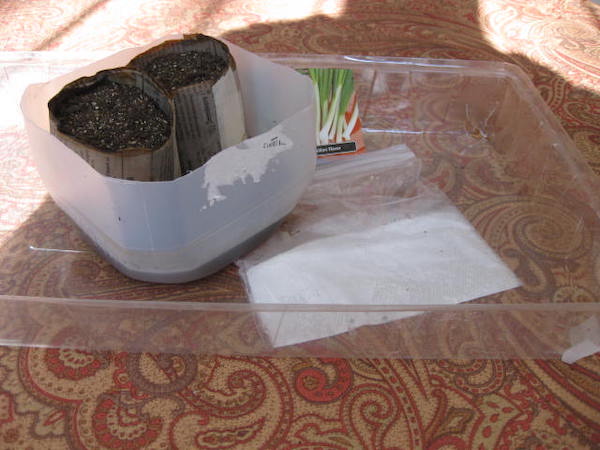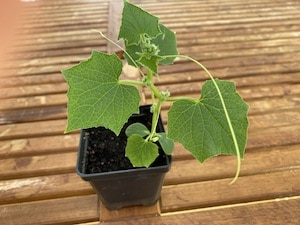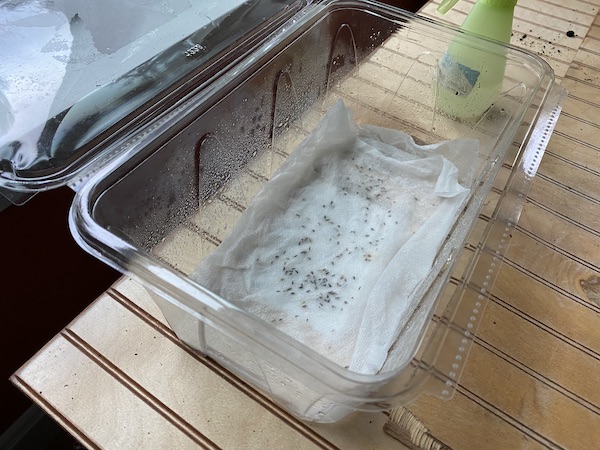Updated: September 2, 2020
Is it worth it to pre-sprout small seeds? Many larger seeds clearly benefit from pre-sprouting before planting. But is that true for small seeds, too?
I tested pre-spouting with bunching onions seeds, which are pretty small. I put five seeds in a paper towel in a small plastic bag. Then I added a little water and put them in a tray over the heating pad.
Three of the five seeds germinated in less than three days.
Then I put the pre-sprouted seeds in a larger than needed paper pot with a half inch of seed starter mix on top and organic potting soil on the bottom.
I used tweezers to gently extract the seeds from the paper towel, being careful not to break the sprout. Then I put the sprouted seeds in the seed starter mix.
Let’s take a sec to get the legal words out of the way. This article may contain affiliate links. That means if you click and buy from my partners, I will make a tiny amount of money at no cost to you. This in no way affects my recommendations.

Pre-sprouted seeds popped up in four days
One of the pre-sprouted seeds emerged from the seed starter mix four days after putting it in the pre-sprouting bag. This is pretty good considering the package says the seeds should come up in seven to 14 days.
But do you think a week or so head start is worth the extra effort?
Let’s look at the pluses and minuses of pre-sprouting to make a decision.

Everything I know about Starting Seeds
All my seed starting and seedling growing articles in one place.
Pluses of pre-sprouting
- Every pre-sprouted seed that you put in seed starter mix is viable. There’s less waste.
- If you only have a few seeds, pre-sprouting will significantly increase your chance of success.
- Seedlings emerge from seed starting mix in about half the normal time.
Minuses of pre-sprouting
- It’s easy to damage pre-sprouts.
- Plants could suffer from root shock.
- It’s more work.
Some people recommend using vermiculite or perlite instead of paper as a pre-sprouting medium.
Both vermiculite and perlite have a balanced pH. This is good for many seed varieties.
Lettuce and spinach are especially hard to direct sow when it’s dry and hot.
— Suburban Hobby Farmer
Both vermiculite and perlite hold air and water well. But I don’t use either.
Vermiculite irritates my throat and makes me cough. So I don’t use it.
It also has been associated with asbestos, too. That’s another reason to avoid it.
I do use perlite in potting mix. But for pre-sprouting seeds I don’t use it.
I tried perlite as a pre-spouting medium during the test and found that it didn’t work as well as a paper towel.

The real advantage of pre-sprouting
Since conducting this test, I’ve found that you really benefit from pre-sprouting small seeds when you starting lettuce in soil blocks for fall planting.
This is because it’s harder to germinate seeds in the heat of summer. Lettuce and spinach are especially hard to direct sow when it’s dry and hot.
Related: Why Start Seedlings Indoors in Summer
Pre-sprouting improves germination. This is especially true when compared to planting outside in the summer heat.
Soil blocks allows you to grow indoors until the cooler fall temperatures kick in.
This gives lettuce and other cool weather leafy greens a very good start even though the temperatures are hot outside.
Related articles that might interest you:
- Five Tips for Starting Seedlings More Cheaply
- Free Seeds from the U.S. Government
- I Tested Seed Starting Mix. This One is Best
Suburban Hobby Farmer is a participant in the Amazon Services LLC Associates Program, an affiliate advertising program designed to provide a means for sites to earn advertising fees by advertising and linking to amazon.com.